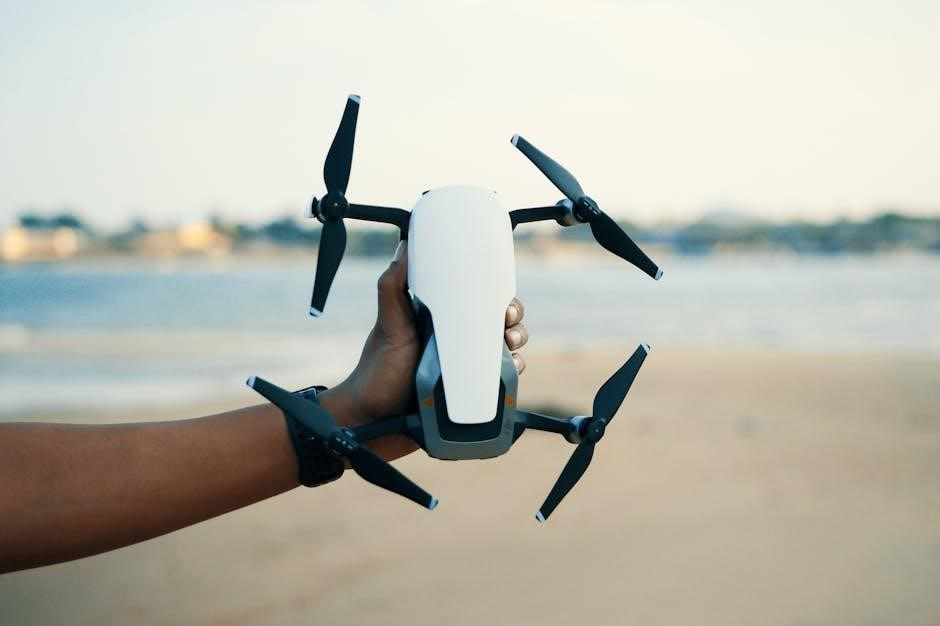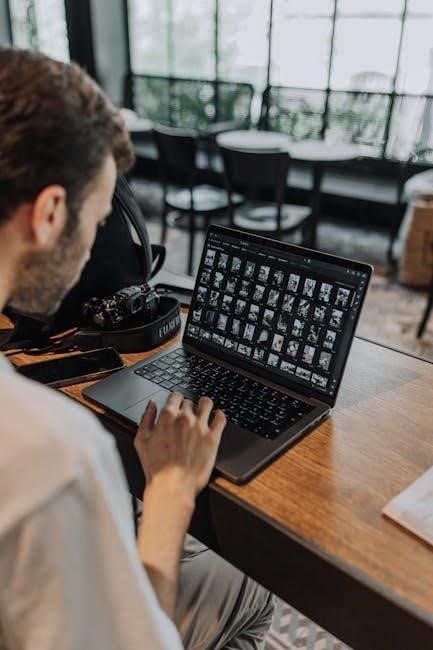Welcome to the KE2 Remote Display Manual. This guide provides comprehensive instructions for installing, configuring, and troubleshooting the KE2 Basic and Combo displays. Designed to enhance your experience with the KE2 Evap OEM controller, this manual covers essential features, advanced settings, and best practices for optimal performance and user safety.
1.1 Overview of the KE2 Remote Display System
The KE2 Remote Display System is designed to provide users with a reliable and intuitive interface for monitoring and controlling their KE2 Evap OEM controller. The system includes two main display options: the KE2 Basic Display and the KE2 Combo Display. The Basic Display offers essential functionality for viewing and adjusting primary setpoints, while the Combo Display expands on this with advanced features such as remote monitoring, alarm systems, and control capabilities. Both displays are engineered to integrate seamlessly with the KE2 Evap OEM controller, ensuring precise temperature management and operational efficiency. This system is ideal for users requiring either simple or advanced control solutions.

Types of KE2 Displays
The KE2 system offers two primary display options: the KE2 Basic Display and the KE2 Combo Display. Each provides distinct features tailored to user needs, ensuring optimal functionality.
2.1 KE2 Basic Display
The KE2 Basic Display is a compact and essential component for monitoring and adjusting key settings of the KE2 Evap OEM controller. It is shipped with most KE2 Evap OEM controllers and provides direct access to major setpoints, allowing service technicians to perform necessary adjustments efficiently. The display features a user-friendly interface with basic controls, ensuring ease of operation. While it does not include advanced features like remote monitoring or alarms, it serves as a reliable tool for essential system management. For more detailed operations, users can also access setpoints via the KE2 Combo Display or the controller’s web interface.
2.2 KE2 Combo Display
The KE2 Combo Display is an advanced version of the remote display, offering enhanced functionality for the KE2 Evap OEM controller. It combines a temperature display with additional features such as lighting control, panic alarm, and door heater management. Designed for versatility, the Combo Display can operate with one or two KE2 Evap OEM controllers, making it ideal for more complex systems. Users can access and adjust setpoints directly from the display, while preprogrammed settings ensure ease of use. The Combo Display also supports remote monitoring and control, providing greater convenience for system management. Its robust feature set makes it a preferred choice for advanced applications and multi-controller setups.

Installation and Setup
Install the KE2 Evap OEM controller and ensure all components are properly connected. Verify the remote display is securely linked, with cables undamaged and fully inserted into jacks.

3.1 Hardware Requirements for Remote Display
The KE2 Remote Display requires compatible hardware to function optimally. Ensure the KE2 Evap OEM controller is properly installed and connected. Use undamaged, factory-approved cables, with a maximum length of 5ft between the controller and display. Verify all ports are clean and free from damage. The remote display must be mounted securely, avoiding extreme temperatures or moisture. For extended setups, consult KE2 Therm for approved extensions. Always use genuine KE2 accessories to maintain performance and reliability. Proper hardware setup ensures seamless communication and accurate temperature monitoring. Follow all safety guidelines to prevent damage and ensure optimal system operation.
3.2 Connecting the Remote Display to the KE2 Evap OEM Controller
Connect the KE2 Remote Display to the KE2 Evap OEM controller using the provided communication cable. Power down the controller before connecting to avoid damage. Locate the designated ports on both devices and ensure the plugs are fully inserted. Verify the connection is secure and free from damage. Power up the controller and check the display for proper communication. If issues arise, inspect the cable for burns, cuts, or frays. Replace damaged cables immediately. Ensure the remote display is mounted in a stable, accessible location. Proper connection ensures accurate temperature monitoring and control. Follow all safety guidelines to prevent electrical hazards during setup.

Troubleshooting Common Issues
Identify common issues like communication failures or damaged cables. Check connections, inspect for damage, and ensure proper setup. Refer to the manual for detailed solutions and precautions.
4.1 Remote Display Not Communicating with the Controller
If the remote display fails to communicate with the controller, first ensure all connections are secure. Verify that the communication cable is fully inserted into both the controller and the display. Inspect the cable for any signs of damage, such as cuts, burns, or fraying, and replace it if necessary. Check the maximum cable length, as exceeding the recommended 5ft may cause issues. Restart both the controller and the display to reset the connection. If problems persist, consult the troubleshooting section of the manual for advanced diagnostics or contact technical support for further assistance. Proper communication is essential for optimal functionality.
4.2 Damaged or Faulty Cables
Damaged or faulty cables are common issues that can disrupt communication between the remote display and the controller. Always inspect the cables for signs of damage, such as cuts, burns, or fraying. If any damage is found, replace the cable immediately to ensure proper functionality. Ensure the cable is fully inserted into both the controller and the display. The maximum recommended cable length is 5 feet; exceeding this may cause connectivity issues. If using an extended cable, contact KE2 Therm for guidance. Regularly check and maintain cables to prevent such problems, as they are critical for reliable operation of the remote display system.
Advanced Features of the KE2 Combo Display
The KE2 Combo Display offers advanced features such as remote monitoring, lighting control, panic alarms, and door heater management, enhancing functionality and system integration seamlessly for users.
5.1 Remote Monitoring and Control Capabilities
The KE2 Combo Display enables remote monitoring and control of your system, allowing users to access real-time data and adjust settings from a distance. Through the KE2 Local Area Dashboard, you can monitor temperature, alarms, and performance metrics across multiple controllers. This feature is particularly useful for managing large installations or multiple units efficiently. The remote control function lets you modify setpoints, toggle outputs, and receive notifications, ensuring optimal system performance. With secure access and user-friendly interface, the KE2 Combo Display simplifies remote management, reducing the need for on-site visits and enhancing operational efficiency significantly.
5.2 Alarm Systems and Notifications

The KE2 Combo Display features advanced alarm systems and notifications to ensure timely alerts for critical system conditions. These include panic alarms, temperature deviations, and door status notifications. Alarms are displayed visually on the screen, with detailed descriptions to help users identify issues quickly. Notifications can also be sent remotely through the KE2 Local Area Dashboard, allowing for prompt action. Customizable thresholds enable users to set specific conditions for alerts, minimizing false notifications. The system ensures continuous monitoring and rapid response, enhancing overall system reliability and operational efficiency. This feature is essential for maintaining optimal performance and addressing potential issues before they escalate. Regular updates keep the alarm system accurate and effective.

Accessing and Adjusting Setpoints
Accessing and adjusting setpoints is straightforward via the KE2 Combo Display or the controller’s web interface. Both displays allow easy customization of temperature, defrost, and fan settings. Setpoints are preprogrammed but can be manually adjusted for precise control.
6.1 Navigating the Setpoints Menu
Navigating the setpoints menu on the KE2 Remote Display allows users to easily access and modify critical system settings. Press the MENU button to enter the setpoints interface. Use the navigation buttons to scroll through categories such as temperature, defrost, and fan settings. Highlight the desired setpoint using the arrow keys and press ENTER to view or adjust its value. The ADJUST button enables manual changes, while the SAVE button ensures your settings are stored. Always review changes before exiting to confirm accuracy. The system provides clear prompts and status updates, ensuring a user-friendly experience. Refer to the on-screen instructions for additional guidance.
6.2 Manual Adjustment of Setpoints
Manually adjusting setpoints on the KE2 Remote Display ensures precise control over system operations. Access the setpoints menu by pressing the MENU button and navigating to the desired category. Use the arrow keys to select the setpoint you wish to modify, then press ENTER to view its current value. Adjust the value using the ADJUST button, and confirm changes by pressing SAVE. For example, adjust room temperature setpoints (rtp) or defrost timings as needed. The system will display a confirmation message after saving. Always ensure adjustments align with operational requirements and safety guidelines. Refer to the on-screen instructions for specific setpoint ranges and limitations.
Safety Precautions and Best Practices
Always handle the KE2 Remote Display with care to avoid damage. Ensure cables are undamaged and securely connected. Mount the display in a stable, dry location, avoiding extreme temperatures or humidity. Follow all installation and operational guidelines to ensure safe and reliable performance.
7.1 Handling the Remote Display
Handle the KE2 Remote Display with care to prevent damage. Avoid touching the screen excessively, as oils from skin can cause degradation. Clean the display with a soft, dry cloth, avoiding harsh chemicals. Ensure the unit is mounted securely to prevent accidental drops. Store the display in a dry, cool environment when not in use. Do not expose it to direct sunlight or extreme temperatures, as this may cause malfunctions. Always disconnect the power before cleaning or servicing. Follow proper electrostatic discharge precautions to protect internal components. By adhering to these guidelines, you can ensure the longevity and reliability of your KE2 Remote Display.
7.2 Mounting the Remote Display
Mounting the KE2 Remote Display requires careful attention to ensure proper functionality and safety. Choose a stable, flat surface for installation, avoiding direct sunlight and moisture. Use the provided mounting hardware to secure the display firmly to prevent movement during operation. Ensure the display is at an optimal viewing angle and easily accessible. Follow the manufacturer’s guidelines for hole alignment and screw placement. Avoid over-tightening, as this may damage the unit. If unsure, consult a professional for assistance. Proper mounting ensures reliable performance and longevity of the KE2 Remote Display, while also maintaining a safe working environment.

